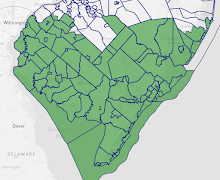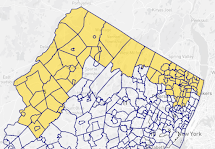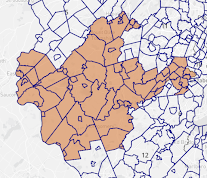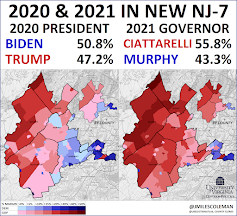US Midterm Election 2022
US General Election 2024
History In The Making
NJ's Congressional Districts: A Deep Dive
New Jersey's New Districts: A Deep Dive
New Jersey's 2022 House Of Representatives Competitions
N J looking good for democrats
The redded year 2022
A Poltical Prediction Study On 2024 US Election
Mohammad Sohrab Aziz
New Jersey NJ
On Wednesday, the New Jersey Redistricting Commission adopted Congressional districts for the next decade. Tiebreaking commissioner John Wallace backed the Democratic plan, arguing that it was a fair move because Republicans drew the lines last cycle.
The new boundaries benefit most of the Garden State's vulnerable Democratic incumbents, with Mikie Sherrill (NJ-11), Josh Gottheimer (NJ-05), and Andy Kim (NJ-03) all receiving safer seats just in time for what is expected to be a Republican year. Embattled 7th district Congressman Tom Malinowski was the only unlucky Democrat, and is now an underdog for reelection.
Had the Republican proposal been adopted, all of the competitive Democratic seats would have been at risk next year. Given the favorable Democratic trends throughout North Jersey, though, such gains would likely be temporary. Ultimately, the runner-up map seemed like nothing more than a short term solution for Republicans. Speculation is just speculation.
So that's that. New Jersey completed another decennial redistricting cycle. In typical fashion for the machine-dominated Garden State, the commission debated and passed a map that no one in the public had been able to see. Such a clandestine conclusion to an otherwise mundane process should surprise no one with even the slightest understanding of Jersey politics.
So without further ado, let us take a deep dive into the districts receiving the most attention so far.
Data Credit
(Note: The data contained within this article was generously borrowed from a map completed in DRA by Ethan Chen @ECaliberSeven; Gubernatorial numbers were generously provided by @JMilesColeman)
NJ-02 (Trump + 5.1)
Courtesy of DRA
Encompassing many of the Garden State's forgotten wonders, South Jersey's 2nd district stays true to form under the new lines. It still includes all of Atlantic, Cape May, Cumberland, and Salem counties, taking in everything from vegetable farms scattered across pine-strewn wilderness to tourist havens along the shore like Wildwood and Atlantic City. Minor changes include shedding portions of Burlington and Camden counties in favor of new territory in Gloucester and Ocean.
The effects on the 2nd's partisanship are mostly minute, though the new seat is more Republican on paper by about a point. Red year or not, the redesign is good news for Congressman Jeff Van Drew. At the time of his election to the open seat of veteran Republican Frank LoBiondo in 2018, Van Drew was a career Democrat - and a conservative one at that. He defected from his party during President Trump's first impeachment before winning a hard-fought reelection over Democrat Amy Kennedy.
The former state Senator has expanded his regional popularity far beyond his native Cape May since his Senate days, undoubtedly reading the tea leaves (and his region's favorable Republican trends) to make the politically-optimized decision to switch parties. As one might expect, the erstwhile dentist's change of heart has left him exposed as one of the most moderate Republicans in the party's caucus. But that probably will not hurt him at the ballot box considering New Jersey's affinity for the traditional pragmatism of the GOP. When it comes to primaries, he will be secure as long as he has the line on his side.
Democrats could make the new 2nd district competitive under the right conditions, but their odds of winning the seat outright would remain slim regardless of the national scene. The party's weak candidate bench does not help its chances either. Additionally, Van Drew was able to outperform Trump in the state's reddest swing district in a reelection battle than many pundits predicted he would lose. In a Republican midterm with a reddened seat and a lack of credible opposition, there is no reason to expect the two-term Congressman to be at risk; he could very well end up winning by double digits.
For a Democrat to win the seat, he or she would have to check off a few critical boxes:
- First, he or she would need to win Atlantic County easily - not by 3 points like Kennedy did. Atlantic City and Pleasantville are minority-rich shoo-in components of the Democratic coalition, but Biden-won Egg Harbor, Hamilton, and Galloway are just as important when it comes to extra votes.
- Second, he or she would need substantial margins in diverse Cumberland County communities like Vineland, Millville, and Bridgeton.
- Third, he or she would have to mobilize working class Democrats along the Delaware River to trim the Republican advantage in Gloucester and Salem counties.
- Fourth, he or she would need to perform just well enough in the unwinnable Cape May and Ocean portions to avoid defeat.
Suffice to say, the chance of these four realities coming together in 2018 fashion next year is beyond paltry. Democrats underwent a practical armageddon down south in this November's elections, with Governor Murphy's support evaporating so extensively that even Senate President Steve Sweeney could not hold his legislative seat. If President Biden's approvals continue to sag, these anti-Democratic attitudes will continue to fester. This rightward trajectory could wreak unimaginable havoc on federal races, assuming the collapse in downballot Democratic support is any indication.
When it comes to possible Democratic candidates, there is not much to discuss. No one wants to make an earnest bid if defeat and embarrassment are the most probable outcomes. There has been some speculation that Kennedy will run again, though we see little path for her in a Biden midterm considering her underperformance last year. Sweeney is running for Governor, and would not be interested in reliving his recent loss on a more catastrophic scale even if he wanted to jump into Congress. Most of the party's South Jersey legislators have been defeated or exited Democratic politics altogether.
Three unknown candidates currently compose the Democratic field, and none has a particularly strong warchest. As if the 2nd's Democrats could go no further into the wilderness, an internal poll by Change Research recently showed Van Drew ahead 48-42% over a generic nominee. It is therefore abundantly clear that unless political convention goes out the window between now and next November, the new 2nd is not at all competitive and will not be seriously contested by Democrats. Safe Republican
NJ-03 (Biden + 14.1) (Murphy + 2)
Courtesy of DRA
The 3rd district has been greatly altered in redistricting, with a stark redesign meant to shore up Democratic fortunes for the ensuing decade. In its present form, the seat straddles the line between Burlington and Ocean counties. Such was the nature of a bold contrast between ever-bluer and blood red that produced one of the most competitive Trump-era swing seats. (Over the last two decades, the 3rd was fiercely contested on the Congressional level while remaining partial to Obama) Despite swinging into Trump's column in 2016, and narrowly voting for him in 2020, the 3rd's swing status has been maintained.
Andy Kim is one of the rising stars among the class of House Democrats that swept the nation in 2018. That year, he coupled his national security experience with local roots to build the youthful, outsider status that brought so many promising first-time candidates to victories that would have seemed impossible in 2017. Railing against Congressman Tom MacArthur's ardent opposition to the Affordable Care Act certainly helped the Democratic case, and Kim ended up with a narrow win driven by Burlington County.
There is no doubt that Kim's reelection margin was impressive. He took 4% more of the vote than Biden, pounding out an 8 point win that even saw him crack 40% in Ocean County. A lot of that success can be conceded to Kim's strength, but some of the blame must fall on his unsatisfactory opponent David Richter as well. Had Republicans nominated Kate Gibbs, very much a clone of Brian Fitzpatrick across the Delaware, Kim could have been at greater risk.
The past aside, Kim is not at much risk anymore. Redesigning has made his 3rd into a Biden +14 bastion that should stay true to form amid even the toughest of environments. The district is still predominantly Burlington-based (it finally includes the whole county) but trades all of Ocean for more Democratic additions in Mercer and Middlesex counties. Heavily-populated Hamilton Township, a modestly-blue Trenton shell community, is the most notable inclusion because it is the home of neighboring Congressman Chris Smith.
A Republican could theoretically make the new 3rd competitive in a truly horrific Democratic environment, but winning the seat would be difficult to imagine after the changes. Governor Murphy carried the seat by 2 points, closely mirroring his statewide margin. If Ciattarelli could not win here in November, it is unlikely a weak GOP House candidate will be able to trounce a well-established incumbent in a similar environment. (A Republican would need to carry Burlington County to secure the seat, something even Ciattarelli could not do)
So who is running? Not many contenders. Given the significant changes in partisan lean, many credible Republicans (legislators and local office-holders) that would have otherwise been serious recruits will probably end up passing on runs. This phenomenon creates a similar bench problem to the one Democrats are experiencing in the neighboring 2nd. Out of a sheer abundance of caution given 2022's environmental prospects, we are starting Kim's new bulwark at Likely Democratic.
NJ-05 (Biden + 12.4) (Murphy + 1)
Courtesy of DRA
The 5th remains New Jersey's northernmost Congressional district, with a population primarily based in Bergen County. Like the 3rd and 11th districts, strategic modifications were made to solidify its Democratic lean. Changes give the district more of the Bergen riverfront (Cresskill through Englewood to Palisades Park) in exchange for the removal of Republican Warren County. The alterations make the seat Biden +12, substantially safer than the current Biden +7 district. Apart from those slight boundary updates at its eastern and western extents, the 5th has undergone little geographic change.
In 2016, the seat was flipped blue by Josh Gottheimer. Tracing his roots to the Clinton Administration, the moderate Gottheimer has received his fair share of criticism from political observers of all stripes. Despite the social media rancor, he is a fundamentally perfect fit for the affluent Bergen suburbs that account for the most significant share of the 5th's population.
Unlike its working class counterparts further south, most of upper Bergen is suburban and predisposed to economic conservatism. Gottheimer's crusade against so-called "moocher states" has been well-received, and should remain an effective strategy despite the boundary changes. Gottheimer was reelected easily twice, and managed to outrun Biden in 2020. He is certainly more suited for the current seat than his conservative predecessor Scott Garrett, a consistent underperformer who lost after a feud with the NRCC in 2016. (Trump actually won the 5th and 11th that year)
Some have said Gottheimer should change his rhetoric since his redrawn seat is much bluer. They have reasoned that he would be at risk from a primary challenge driven by disaffected Democrats. Besides the fact that the Gottheimer brand is popular throughout the 5th, one must note that primary challenges against incumbent Congressmen here are hindered by machine politics - namely the omnipotence of the county organizational lines.
Excluding double-bunking contests between two incumbents, the last time a challenger defeated a sitting Representative in a primary was 1958. Even then, the Hudson County machine had turned on the incumbent. There has been a handful of somewhat-close calls since then (Roukema v Garrett, Lance v Larsen, Helstoski v Baer) but each challenger has ultimately lost. Assuming Gottheimer can maintain the Bergen line, there is no reason to expect him to be going anywhere come primary time.
What about Republicans? The redesign is certainly a blow to GOP chances. Frank Pallotta would probably be able to ride the national environment to a rematch victory under the current lines. But Republicans are not completely out of the picture. Compared to the new 3rd and 11th, the 5th experienced the smallest change in partisanship. What does that mean? Someone like Pallotta could still give Gottheimer a close race next year. Republicans also maintain a downballot presence in Bergen even though Ciattarelli lost the county in November.
Nevertheless, it is impossible to ignore the reality of the line changes: a Republican probably needs to win Bergen to win the district. That is easier said than done, since none of Gottheimer's previous three opponents has come close to doing so. Given the expropriation of the entire Warren portion, the electoral significance of Bergen is magnified to new heights. Much like in the updated 3rd, the GOP could exceed expectations in a favorable year, but a win remains unlikely. Likely Democratic
NJ-07 (Biden + 3.4) (Ciattarelli + 12)
Courtesy of DRA
Overall, the redrawn map makes the 7th significantly more Republican. The seat's new iteration is just Biden +4, down from its Biden +11 watermark. Most of the partisan change can be traced back to the GOP bastions of Warren and Sussex, both of which are now at least partially included in the 7th. Heavily-Democratic municipalities like North Plainfield, Union, and Montgomery find themselves drawn out of the new seat. While a four-point Biden district might normally mesh well with the Democratic column, there are a couple of extraneous factors that make the 7th's mere partisan lean misleading at best.
Let us start with the incumbent: Democrat Tom Malinowski. He rode the district's trends, and the unpopularity of President Trump, to unseat long-time Republican Leonard Lance in 2018. After his election, things seemed rather auspicious. Then things started to change. In 2019, down ballot Republicans held up extremely well in legislative elections - the first sign that ticket splitting was still potent in the Trump-era.
That legislative success proved to be a good harbinger for Republicans, with Tom Kean Jr. nearly defeating Malinowski in 2020 despite Biden's bloated margin in the 7th. Kean's name and multi-decade state Senate tenure gave him the political capital necessary to run a close race.
Considering the top-line obstacle, the fact that Kean held Malinowski to the narrowest reelection margin of any Democratic incumbent nationwide is quite impressive. His moderate record allowed him to perform much better than most pundits gave him credit for prior to the election; the race was always more Tossup than Lean Democratic, though few ever agreed in October.
Rattled by his near loss and underwhelming performance, Malinowski immediately started fundraising to prepare for his next reelection - one he would be keen on fortifying. Then his stock scandal broke, birthing rancid allegations of insider trading. Malinowski continues to be investigated by the House Ethics Committee as of this writing, though he has not dealt with any serious reprimand. The scandal likely complicates what would have been an already difficult reelection.
Now let us take a look at how the new map affects the race. As mentioned, the design changes make the district more Republican on its face. Besides that, Republicans will probably benefit from their strong downballot strength. Miles's generous map shows just how well Ciattarelli performed in November, painting a picture of what a Congressional victory would probably look like in a red wave.
Kean's Union County roots also help Republicans, giving them a chance to cut into Democratic margins in the portion of the seat that Malinowski would need to win handily to achieve reelection. Even if Malinowski were able to win the Somerset portion (and that's a big if) he would still lose if he were to significantly underperform in the Union sliver. Kean's Biden +18 Senate district is perfectly situated between the two critical counties, making it a perfect medium through which to appeal to swingable Biden voters and disaffected Democrats. In short: Kean has the strongest connections with voters that Malinowski desperately needs.
Malinowski has still not decided whether he will seek reelection following all of the recent complications. Sacrificed by Democrats to shore up his colleagues in competitive districts, the two-term Congressman must now ponder his future. He is not dead on arrival, but he begins reelection as an underdog if he decides to run. Candidate quality and regional appeal still go a lot farther in New Jersey than they do in other states, something Kean is well aware of. Lean Republican
Assuming North Jersey trends continue to look promising for Democrats, Kean could find himself in hot water in a more favorable Democratic environment. If Republicans win the Presidency in 2024, the succeeding midterm could pose a death blow. For now, though, he seems poised to oust an incumbent that no one in either party will particularly miss.
NJ-11 (Biden + 16.8) (Murphy + 6)
Rooted in Morris County, perhaps one of the most politically-fascinating entities in the nation, the 11th district gets sizably bluer in redistricting. Morris is trending Democratic (it backed Biden last year) but it remains fairly Republican downballot, backing the party that controls the county government. Ciattarelli also managed to hold on to Morris, improving Republican numbers slightly from 2017.
Besides its centrally-located Morris foundation, the 11th continues to encompass parts of Essex and Passaic counties. The biggest geographic change comes from shedding the seat's small Sussex portion to take in Essex communities like South Orange Village. Likely a nod to the incumbent, the latest iteration of the 11th now includes all of Montclair. (It no longer includes West Orange)
Democrat Mikie Sherrill was one of many successful Democratic outsiders in 2018 who capitalized on her image and a perfect storm environment to win a previously-untargeted seat. Before her, veteran Republican Rodney Frelinghuysen held a lock on the 11th. Given that he was electorally untested, another reelection victory amid a toxic environment would not have been assured. Had he run, though, he would have certainly kept the race against Sherrill closer than Webber did.
Since her victory, Sherrill has attempted to place herself at the center of the Democratic caucus. She faced a closer than expected challenge from Rosemary Becchi in 2020, but still ran ahead of Biden. Her new district is a welcome reprieve, removing Republican territory in Sussex and Passaic counties and replacing it with new ground in reliably-Democratic Essex.
The redrawn 11th clocks in at Biden +17, putting it in the safety zone for Democrats - especially one as strong as Sherrill. State Senator Tony Bucco Jr., a top recruit, probably will not enter the race following the redraw. With a denuded reelection still on the cards next year, the former Navy helicopter pilot can turn her attention to the 2025 Gubernatorial race. Safe Democratic
Conclusion
Criticisms of the redistricting process and its outcome aside, the new map is very good for Democrats. It locks in every Democratic incumbent except Malinowski, while keeping his 7th district within striking distance for Democrats in a better environment. Considering how much the Republican-drawn Congressional map of the last decade ended up falling apart, predicting map futures is a woefully-uncertain game. But we can at least be confident in saying that the new map prevents four would-be flips if the current lines were up next November.
Split Ticket 🎟












Comments